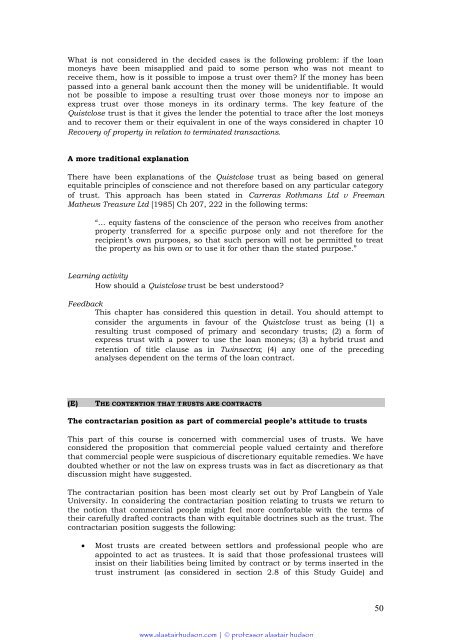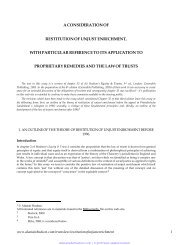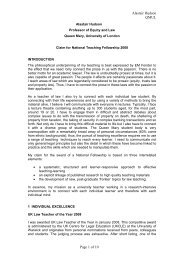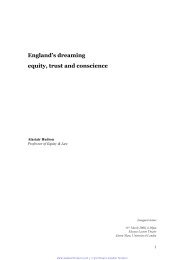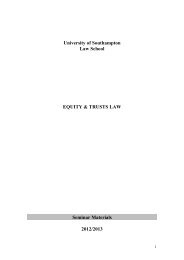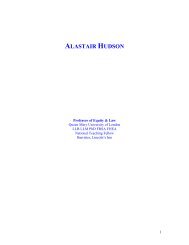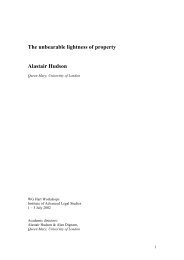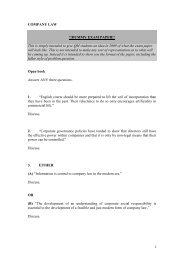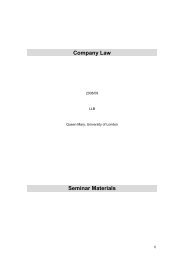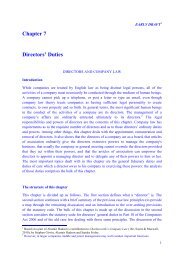Advanced Equity and Trusts Law - alastairhudson.com
Advanced Equity and Trusts Law - alastairhudson.com
Advanced Equity and Trusts Law - alastairhudson.com
Create successful ePaper yourself
Turn your PDF publications into a flip-book with our unique Google optimized e-Paper software.
What is not considered in the decided cases is the following problem: if the loan<br />
moneys have been misapplied <strong>and</strong> paid to some person who was not meant to<br />
receive them, how is it possible to impose a trust over them? If the money has been<br />
passed into a general bank account then the money will be unidentifiable. It would<br />
not be possible to impose a resulting trust over those moneys nor to impose an<br />
express trust over those moneys in its ordinary terms. The key feature of the<br />
Quistclose trust is that it gives the lender the potential to trace after the lost moneys<br />
<strong>and</strong> to recover them or their equivalent in one of the ways considered in chapter 10<br />
Recovery of property in relation to terminated transactions.<br />
A more traditional explanation<br />
There have been explanations of the Quistclose trust as being based on general<br />
equitable principles of conscience <strong>and</strong> not therefore based on any particular category<br />
of trust. This approach has been stated in Carreras Rothmans Ltd v Freeman<br />
Mathews Treasure Ltd [1985] Ch 207, 222 in the following terms:<br />
“… equity fastens of the conscience of the person who receives from another<br />
property transferred for a specific purpose only <strong>and</strong> not therefore for the<br />
recipient’s own purposes, so that such person will not be permitted to treat<br />
the property as his own or to use it for other than the stated purpose.”<br />
Learning activity<br />
How should a Quistclose trust be best understood?<br />
Feedback<br />
This chapter has considered this question in detail. You should attempt to<br />
consider the arguments in favour of the Quistclose trust as being (1) a<br />
resulting trust <strong>com</strong>posed of primary <strong>and</strong> secondary trusts; (2) a form of<br />
express trust with a power to use the loan moneys; (3) a hybrid trust <strong>and</strong><br />
retention of title clause as in Twinsectra; (4) any one of the preceding<br />
analyses dependent on the terms of the loan contract.<br />
(E) THE CONTENTION THAT TRUSTS ARE CONTRACTS<br />
The contractarian position as part of <strong>com</strong>mercial people’s attitude to trusts<br />
This part of this course is concerned with <strong>com</strong>mercial uses of trusts. We have<br />
considered the proposition that <strong>com</strong>mercial people valued certainty <strong>and</strong> therefore<br />
that <strong>com</strong>mercial people were suspicious of discretionary equitable remedies. We have<br />
doubted whether or not the law on express trusts was in fact as discretionary as that<br />
discussion might have suggested.<br />
The contractarian position has been most clearly set out by Prof Langbein of Yale<br />
University. In considering the contractarian position relating to trusts we return to<br />
the notion that <strong>com</strong>mercial people might feel more <strong>com</strong>fortable with the terms of<br />
their carefully drafted contracts than with equitable doctrines such as the trust. The<br />
contractarian position suggests the following:<br />
� Most trusts are created between settlors <strong>and</strong> professional people who are<br />
appointed to act as trustees. It is said that those professional trustees will<br />
insist on their liabilities being limited by contract or by terms inserted in the<br />
trust instrument (as considered in section 2.8 of this Study Guide) <strong>and</strong><br />
www.<strong>alastairhudson</strong>.<strong>com</strong> | © professor alastair hudson<br />
50


